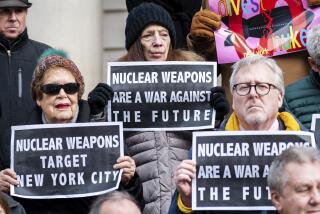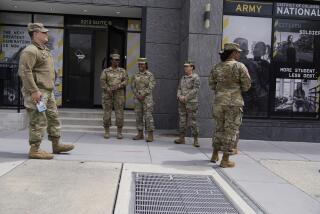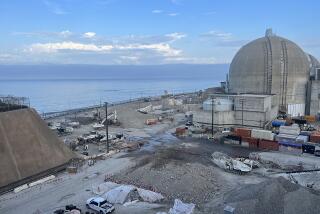Bush Plan Aims to Slash Supply of Nuclear Arms
- Share via
The Bush administration has sent to Congress a classified plan to reduce the U.S. nuclear weapons stockpile by almost half, leaving a maximum of 2,200 warheads deployed at defense facilities and thousands of additional warheads in reserve.
By the time the reductions are completed in 2012, the stockpile would be at its lowest point in decades, said Linton Brooks, chief of the Energy Department’s National Nuclear Security Administration.
The government has never disclosed how many such weapons it has; outside experts long have estimated that after the Cold War, the United States retained about 7,000 strategic warheads, 1,000 smaller warheads intended for tactical battle, and 3,000 reserve warheads.
Brooks said the proposal represented the largest percentage cut ever in the nation’s nuclear inventory. Since the 1980s, the U.S. has been taking bombs out of its inventory and disassembling them at a plant in Amarillo, Texas.
The U.S. produced an estimated 70,000 nuclear bombs after World War II, churning out 25 warheads per day at its peak in the mid-1960s. The nation was operating 925 uranium mines to keep the production going, according to a 1995 Brookings Institution study of the Cold War.
But arms control experts have said that the current stockpile was still bloated, given the reduced threat of a large-scale nuclear war. That excess, critics say, translates into billions of dollars of unnecessary spending and raises the risk of a terrorist attack on U.S. nuclear facilities.
“The U.S. can do with many fewer deployed weapons,” said Daryl Kimball, executive director of the Arms Control Assn., a Washington-based group that has long advocated sharper cutbacks. “These reductions are going far too slowly, and the U.S. is missing a historic opportunity to eliminate the residuals of the Cold War because of bureaucratic inertia.”
Given the power of each bomb and the relatively small arsenals of potential enemies, Kimball said, many experts believed that a few hundred nuclear bombs might represent an effective deterrent against attack.
The reductions outlined by Brooks are part of the Moscow Treaty, negotiated by the Bush administration in 2001, which declared: “The era in which the U.S. and Russia saw each other as an enemy or strategic threat has ended.”
The treaty provided for the United States to deploy between 1,700 and 2,200 strategic nuclear weapons on land-based missiles, submarine-based missiles and bombers -- a two-thirds reduction from the deployments at the time. But it did not address the issue of reserve weapons.
Brooks said the Energy Department’s secret reserves consisted of weapons that are fully maintained and inactive weapons that would need a boost of tritium gas to be useable.
Weapons scheduled for retirement are sent to Amarillo for disassembly, though the process has gone slowly. President George H.W. Bush ordered the destruction of nuclear artillery shells in the early 1990s, for example, but the work was only completed last year, Brooks said.
The plutonium triggers for the disassembled bombs will be stored in Amarillo until they can be chopped up, he said. Uranium components that produce the thermonuclear effect will be stored at a plant in Oak Ridge, Tenn., until they can be blended into fuel for civilian reactors.
Brooks said the smaller inventory eventually would reduce government costs, although the budget for nuclear weapons has escalated in recent years to help assure the reliability and safety of the weapons.
A study by Christopher Paine, a nuclear policy analyst at the Natural Resources Defense Council, one of the nation’s leading environmental groups, indicates that the U.S. is spending 35% more on nuclear weapons now than it did during the Cold War.
By 2009, the Bush administration estimates the U.S. will be spending $7.76 billion to maintain the nuclear stockpile.
More to Read
Sign up for Essential California
The most important California stories and recommendations in your inbox every morning.
You may occasionally receive promotional content from the Los Angeles Times.











